One year ago I sat idly and watched as my friends enjoyed a beautiful, warm winter day of cragging at the New River Gorge in West Virginia. I had just returned from a climbing expedition in Venezuela. My mind wandered from the impeccable sandstone of the New to the equally impeccable stone of Acopan Tepui of La Gran Sabana, a biologically diverse region that occupies 4,200 square miles of southeastern Venezuela. I reminisced of moments from weeks prior: the sound of our machete as it cut through thick vines; the unmistakable metallic squawk of the Bearded Bellbird; waterfalls; flowers; heaven on earth; black flies; dazzling views; big walls; dirt in my eyes; ant bites; the sound of a breaking bone…
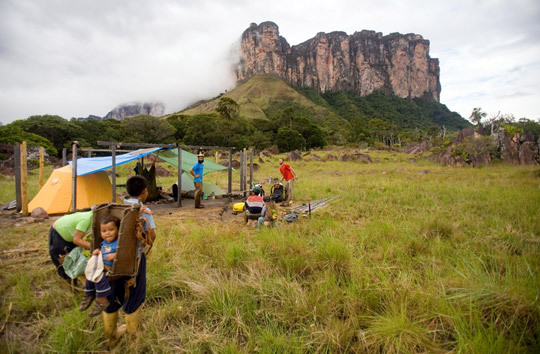
Base camp near Acopan Tepui. Over nine days in February, Jeremy Collins, Pat Goodman, James Q. Martin and Jose Ricardo Miranda established In Gold Blood (V 5.12c A0, 11 pitches) up Acopan Tepui, one of around a dozen major tepuis in the Chimanta Massif, Venezuela. [Photo] Pat Goodman
The pain in my finger shook me from my daydream. A doctor I saw in Venezuela told me to keep it immobilized until it healed. “How long?” I asked. She just smiled and said, “Until it stops hurting.”
In 2012, Jeremy Collins and I spent two weeks of February in La Gran Sabana with Jose Ricardo Miranda, a 34-year-old Venezuelan farmer. Several years ago, he moved from Colorado, where he owned a successful solar company, with his wife Kami and two children, Pas (8) and Kawak (10), back to Venezuela to live off the grid at the Miranda family farm. Jeremy had met Jose at a film fest in Carbondale three years ago. His charismatic, kindhearted nature immediately attracted Jer and soon they were discussing the legendary tepuis of Jose’s homeland.
On the 2012 trip, we were intent on establishing a new route up the multifaceted southeast face of Acopan Tepui. We wanted to take advantage of the great rock and establish a good free route, one that others could enjoy. The three of us put up four pitches on a clean sweep of white and pink sandstone just right of a big waterfall before being shut down by time constraints. I broke my finger in a fall while shuttling heavy loads down. Jose also sprained both ankles in a ledge fall. The promise of gear-sucking horizontals was to no avail, and we spent the days navigating each crackless pitch through a maze of thin holds, hanging from hooks and thin pins, finding the only suitable protection to be bolts.
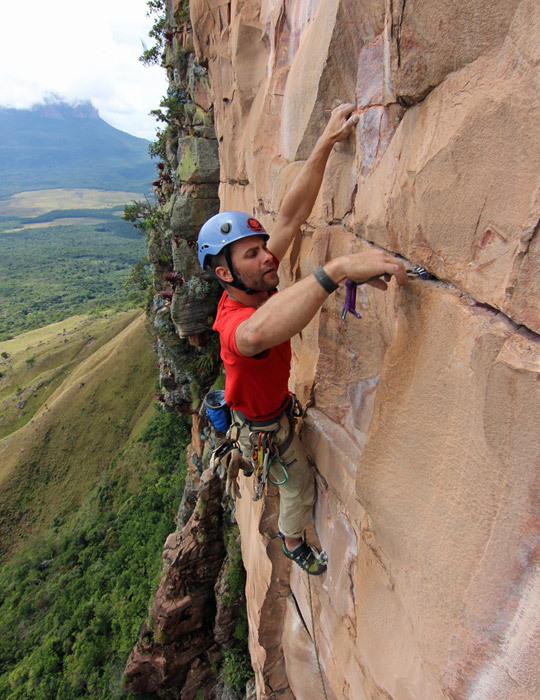
Jeremy Collins eases his nerves with a good piece of pro on Pitch 4 of In Gold Blood. Collins and Goodman climbed the first four pitches of the route on a 2012 trip, but didn’t have enough time to finish the climb. [Photo] Pat Goodman
Perhaps we picked a section of stone dissimilar to cliff line that accommodated other, naturally protected routes like Pizza, Chocolate y Cerveza (5.12+, 600m) or 10 pounds of Tequila (7b+, 330m). Perhaps we lacked vision and machismo. An article by a Venezuelan climber on Desnivel.com criticized our decision to drill. “Contrary style, ethics and vision to tepui climbing, these climbers (we were called out by name) were devoted to drilling and carving the wall. In four long pitches they left 40 bolts. This is an insult, because anyone with a drill can climb the wall without actually being posed to test their skills as climbers.”
To some, the decision to bolt is pretty black and white. “Do not do it.” To others, it’s a shade of grey “No bolts within arm’s reach of natural protection,” is a rule some follow. I think it’s a balance between preserving challenge and maintaining an acceptable safety margin. When that article came out, I was taken aback by the accusation that we drilled without consideration and chipped holds–an insult to my and Jeremy’s climbing ethic. The author is a friend of ours and had encouraged us to climb on that section of cliff. In the end, we learned a lot on that trip and swore we would return to finish the job.
—
February 9, 2013, I’m waiting at a hotel in Ciudad Bolivar across the street from the airport, about 1.5 hours as a Cessna plane flies from the tiny dirt airstrip in Yunek, the closest village to Acopan Tepui. Several days have passed since we bounced into town, sweaty and tired from the 12-hour drive from Caracas in Jose’s ’64 Land Rover, the “Tank.” Jeremy, Jose, James Q. Martin and I are watching the news. The Pemon’s have taken 40-50 army guards hostage at a large gold mine with fists and bows and arrows. They are revolting against the government’s attempt to take control of the vast, mineral-rich countryside the Pemons have called home for centuries. The government has (unofficially) closed all non-commercial airstrips in La Gran Sabana, and nobody is flying.
Dense, roadless jungle separates us from Yunek. Our only transportation options are plane or canoe, so we scour a list of pilots until we finally find someone willing to break the “new rules” for a grossly inflated price.
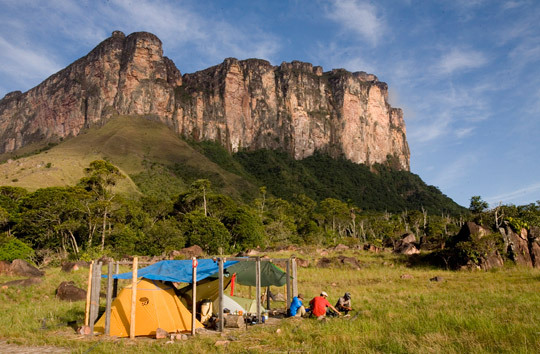
Base camp below Acopan. [Photo] Pat Goodman
A few days later we are on the ground in Yunek, a few hours walk from the base of Acopan and the final staging grounds for climbers wanting to explore the tepuis of the Chimanta Massif. A village occupied by the indigenous Pemon, Yunek houses a dozen or so families, many having up to nine children. They live simply; yuka, pineapples, bananas and fish are their staple food sources. The Rio Karuay is their only “highway” of transport from their isolated location; it’s a two to three-day canoe ride to the nearest modern city where they trade goods to supplement their food rations and other necessities.
When viewed from town, Acopan stands as proud as a fortress, variegated in vibrant orange, pink, white, green, brown and black. The serrated skyline traces a dozen clean, 300- to 600-meter walls separated by waterfalls and vegetated gullies. Acopan is one of around a dozen tepuis in the vast expanse of the Chimanta Massif. With elevations up to 2700m and a footprint hundreds of miles around, Chimanta is considered one of the most important sites of endemism and species diversification in the region.
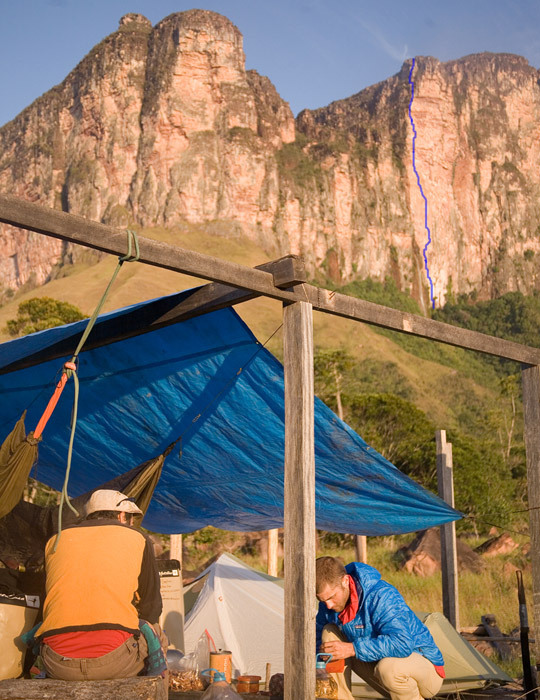
In Gold Blood (V 5.12c A0, 11 pitches), Acopan Tepui, Chimanta Massif, Venezuela. [Photo] Pat Goodman
To describe the landscape, I have to rely on pieces of what I’ve known to create something new–like a dream. Picture this: a karst desert landscape like the vast Castleton area outside of Moab. Instead of Wingate, the towers are dense Precambrian sandstone; instead of vertical fractures, they’re mostly horizontal. Replace the dry washes and dirt of the flat land with a mix of wide-open grasslands, rivers of gold water and dense jungle. No highways or roads. To say it’s isolated is an understatement.
Now, add thick jungle to the talus cones and picture yourself grabbing thick vines for support on the steeper sections as you approach the rock. The sounds of birds chirping and squawking, rustling leaves and ragging waterfalls fill the air. You’re on edge; everything looks like a big snake. Flying ants sting your neck.
—
Jose and I spend a few days reestablishing our highpoint from last year. A mix of ferns, grass and more thick vines covers the first couple hundred feet of dense, vertical rock. Gnats chew our flesh, and mist from a nearby waterfall gives me goose bumps even though it’s 80 degrees in the sun. The holds get smaller–hard 5.12. The horizontal fractures that were gobbling gear down below turn into thin seams. I free climb most everything, save for a rest here and there and a few spots of aid to get the rope up as fast as possible. Hammering in a Birdbeak, I try not to put all my weight on it. A bolt gives me confidence for another 15 feet or so–and repeat. We leave a path of 10mm static for Jeremy and Q to use, and establish a wall camp at our highpoint.
Above, climbing is exposed and steep, maybe 15 degrees overhanging. I bend my neck upward and see a precipitous ocean of pink and red sandstone looming above for a thousand feet; occasionally a big roof pokes out far enough to keep the wall dry, even during a deluge. The texture of each hold is that of 100-grit sandpaper. Perfect.
Over the next three days Jer and Q push upward into the steeper terrain that guarded us from the daily drizzle on the lower pitches. From the ground I could see their progress was way faster than the two days per pitch required on the lower portion of our route.
Meeting up with them again, we make a summit bid. The difficulty of the climbing is solid 5.11, I’m runout, but not alarmed, the holds are positive. Occasionally I encounter some loose or sandy rock, but for the most part it’s as hard as marble. Square-cut angles comprise the gauntlet of familiar hand and foot holds. Sporadically, a vertical fracture offers solid jams.
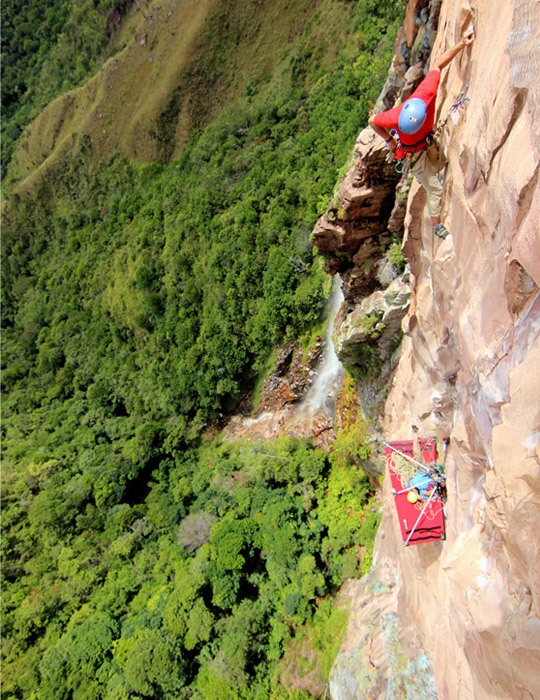
Collins climbing Pitch 4 of In Gold Blood during a 2012 attempt. [Photo] Pat Goodman
With the summit in sight the angle eases. The rock color goes from pink and red to black and green. The rock texture gets a bit more abrasive, and the square-cut angles become more rounded; gear, when available, is solid.
On top it’s windy; I can almost relax into the gales like I would in a La-Z-Boy chair. Suddenly the wind stops. Mounds of sculpted rock pepper the landscape, varying in height, but sharing a similar, otherworldly quality. “Wow! That one looks like a dinosaur!”
Vast jungles, plains and tepuis stretch as far as my eye can see. From the summit I see virgin earth; a land untouched by our noisy, brightly lit society.
—
In Gold Blood (V 5.12c A0, 11 pitches) was established over nine days; five nights were spent on the wall. On the first ascent, they free climbed all except Pitches 2 and 4. Returning to free them, Goodman used “a spot of A0” to avoid a nest of hummingbird-size hornets on the second pitch. Collins fell just short of freeing Pitch 4. –Ed.